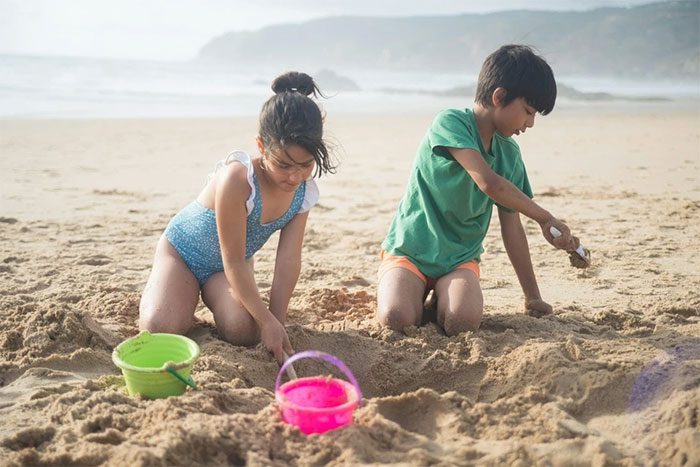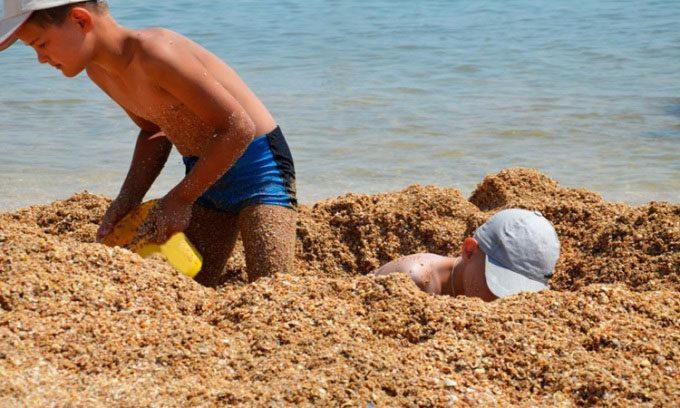Sand holes on the beach, once dry, can collapse, causing those inside to suffocate and face the risk of death.
Dr. Stephen Leatherman (Florida International University, USA) states that deep holes dug in beach sand can become deadly traps.
The Dangers of Sand Holes
Building sandcastles is one of the most popular activities at the beach, but when digging sand for construction, one should avoid digging large holes. Data indicates that sand suffocation can be a greater cause of death than shark attacks, according to IFL Science.
A sand hole is simply a dug-out pit in the sand. Many beachgoers, especially children, enjoy digging as deep as possible. However, the larger the hole, the more dangerous it becomes.
Dr. Stephen Leatherman from the Department of Earth and Environment at Florida International University warns NBC6 that deep holes can become deadly traps. If you want to dig a hole in the sand, ensure it is no deeper than 60 cm.

Many beachgoers, especially children, enjoy digging sand holes for fun. Experts recommend not digging deeper than 60 cm. (Photo: Pexels).
“When people dig holes deeper than 60 cm and crawl inside, at least when their bodies are below the sand surface, the sand will begin to dry out immediately. Dry sand can only sustain a 33-degree angle, while people dig these holes almost vertically,” Dr. Leatherman said.
At that point, the walls of the hole can begin to collapse and do so very quickly. Dr. Leatherman also points out the risk of someone stepping on the edge of the hole before the sand dries, causing a serious collapse.
“The deeper the hole, the greater the risk of collapse, and rescuing someone trapped in a deep sand hole is very difficult,” Dr. Leatherman emphasizes.
“People think sand hole collapses are similar to avalanches, but they are actually very different. In an avalanche, victims can still be rescued because the snow is relatively light, and it can break into small chunks with pockets of air. Sand does not work that way. Sand can easily shift around you and is very heavy. Therefore, trying to rescue a victim is extremely difficult and nearly impossible“, Dr. Leatherman explained.
Unlike landslides that can create air pockets to sustain life for those trapped inside, sand fills every available corner, leading to a rescue window of only a few minutes before suffocation occurs. The most crucial first step is to try to create a breathing space by elevating the trapped person’s mouth above the sand layer. The safest way to rescue someone is to place a board and use special tools to pull them out.
Wet sand is also very dangerous, but a person is less likely to be completely submerged. Quicksand is a thick mixture that can consist of any fine-grained material like sand, silt, or clay. When mixed with the right amount of water, it behaves like a solid, but it operates like a viscous liquid. It can act as a non-Newtonian fluid, meaning if you punch down, quicksand behaves more like a solid and is less sticky, but if you step slowly on it, you will sink. If you struggle or move suddenly, you will become stuck even deeper.
According to a 2005 study published in the journal Nature, humans float better in quicksand if they do not struggle too much and do not bury themselves. The study’s findings indicate that those trapped in quicksand are not at risk of being completely submerged but may only sink halfway. If you find yourself in such a situation, you should remove any heavy items like backpacks and then lean back to distribute your weight more evenly over the surface of the quicksand, making it easier to escape.

Digging holes to build sandcastles is a very popular activity on beaches. (Photo: Frommer).
There Have Been Many Deaths
Dr. Leatherman notes that while people rarely hear about quicksand collapse accidents, many have died in the USA due to this reason.
According to news reports and a medical study in 2007, approximately 3-5 children die each year in the USA due to being buried by collapsing sand holes while digging at the beach, parks, or even at home. Many other cases have resulted in serious injuries requiring CPR to survive.
Fatalities include a 17-year-old who was buried at a beach in North Carolina last year, a 13-year-old who was digging a cave in the sand dunes at a state park in Utah, and an 18-year-old who was digging sand with his sister at a beach in New Jersey. These two accidents occurred in 2022.
“The risk of these accidents is easily misleading because it is associated with a fun, recreational environment – which is often not considered dangerous,” concluded the study published in the New England Journal of Medicine.
It is evident that sand brings joy to many people. Dr. Leatherman says he completely understands that.
However, he also emphasizes that people should not dig deep holes at the beach. If you do dig, make sure it is no deeper than 60 cm and remember to fill it back in when you leave. Keeping holes shallow will alleviate concerns about collapse.
He also advises parents to pay attention to the size of the holes their children are digging and prevent them from digging too deep.
“We all love playing in the sand. But if you play, build sandcastles and dig very shallow holes,” Dr. Leatherman advises.


















































